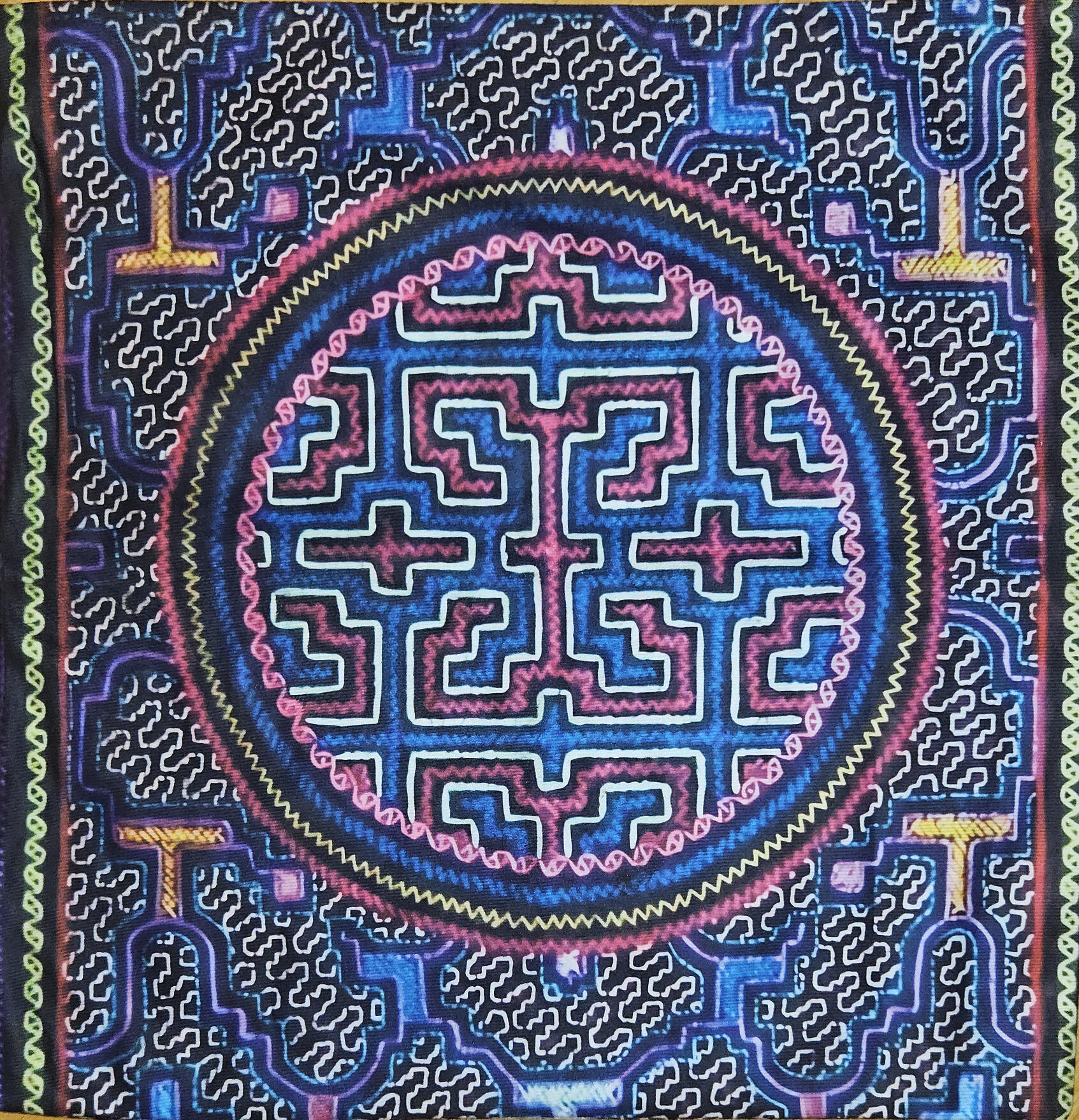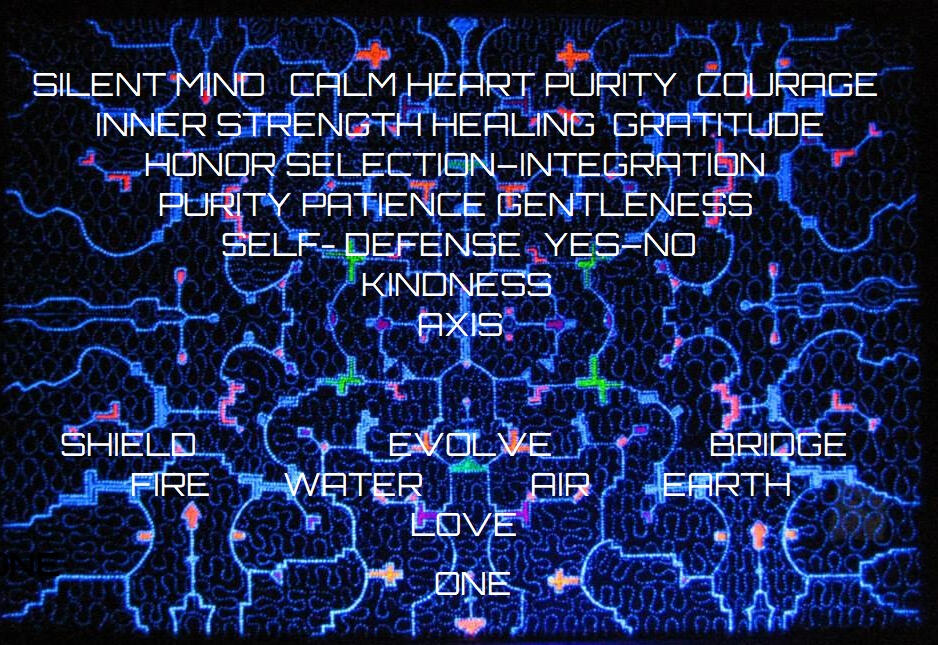INTEGRATION PATTERNS AND THEIR USE

ANALYSIS OF THE IMAGE AND ITS USE IN INTEGRATION WORK
I. Origins and Cultural BackgroundThe pattern shown in the image is a traditional Shipibo-Konibo visual structure.
The Shipibo-Konibo are an Indigenous shamanic community living in the Peruvian Amazon, whose ceremonies are centered around ayahuasca.Their textile art and body painting are not merely decoration, but a coded sacred system — visual representations of sounds, healing songs (icaros), energetic pathways, and states of consciousness.The designs are not “created” in the usual sense, but seen by master healers during ayahuasca ceremonies and then translated into visual form on cloth, wood, skin, or directly onto the body. Each pattern is therefore the visual “language” of an inner vision, a frequency, a healing program.II. Symbolic Layers Visible in the Image
1. The Central GeometryAt the center appears a symmetrical, labyrinth-like structure — a map of the inner world. It reflects the architecture of the self: branching paths, choices, reflections, passages, and connections. The structure is not linear, but follows an energetic logic.Colors and their meanings:Blue — the unconscious, water, healing.Pink/Magenta — the heart center, compassion, the frequency of love.White contours — purity, protection, and codes of higher spiritual vibration.This central pattern is especially important in integration: it helps organize memories and visions brought up by ayahuasca, serving as an energetic map for inner processing.2. The Circular FrameThe central design is surrounded by a double circle, symbolizing protection and closure — a spiritual membrane shielding the traveler and holding the ceremonial space.Inside the circle run zigzag lines of different colors:Green — life force, nature, regeneration.Purple — transcendence, psychic powers, the dream realm.Gold — spiritual wisdom, inner light, divine intelligence.This protective boundary ensures that the experience becomes a framed and integrated whole, rather than fragmented impressions scattered in the mind.3. The Background PatternThe entire image is interwoven with a dense field of small, wavy white lines. These represent energetic connections, neural pathways, and the collective unconscious network.The link between background and center shows that inner changes do not affect only the individual — they ripple out into the collective field. One person’s transformation resonates with others.In integration, this background is key: it allows the experience to embed into the subconscious, stabilizing the journey’s results within both personal and collective systems.III. Practical Uses During Integration
1. As a Meditation Focal PointThe image can serve as the focus in guided or personal meditation. Gazing into its center helps structure the emotions and visions remaining after ayahuasca. The mind naturally calms, and inner images resurface — the design provides clarity and guidance.2. For Visualizing IcarosMany patterns are direct visualizations of icaros (healing songs). During integration, one can re-listen to the specific icaro while tracing the design with eyes or fingers, reactivating the memory and its healing effect.3. Reprogramming the Field of ConsciousnessThe symmetry and color combination organize mental space. This is vital after experiences of ego dissolution or identity loss. The design supports reconstruction, helping to build a new sense of self.4. In DreamworkPlaced near the bed or under the pillow, the design can appear in dreams, guiding processing and preventing fragmentation. Shipibo patterns act like directed dream structures — bringing awareness into the dream space.5. As a Companion to Ritual JournalingThe design may serve as a background or inspiration when journaling or drawing after ceremony. It activates inner maps and aids remembrance, functioning as a key to deep memories.IV. Summary: Symbolic and Psychological ImpactThis pattern is not a mere aesthetic object. It has function: it arranges energy, shapes consciousness, and builds a bridge between the ceremonial experience and daily life.In integration, it becomes a gateway — ensuring that the inner journey is not forgotten, but transformed into lasting growth.
Integration Practice – 5–10 Minutes with the Healing Textile Pattern
Begin by preparing the piece of textile that carries the healing design.
Place it in front of you so that you can see it fully, without strain. Ideally, hang it on a wall, set it on a stand, or lay it on a table at eye level.Choose a quiet, undisturbed place where you will not need to attend to anything else for at least 5–10 minutes. Turn off your phone, lower the noise of the outside world.Sit comfortably, with a straight back and a relaxed posture. Gaze at the textile as though it were a living map before you — not with analysis, but with curiosity and presence.Take three deep breaths. As you inhale, feel your chest fill. As you exhale, release the remnants of the day — thoughts, tensions, worries. Allow yourself to be here now, with nothing but you and the pattern.Now direct your attention to the center of the design. Rest your gaze there for a few moments. Imagine that this center is not only on the fabric, but within you — pulsing deep in your chest, behind your heart, or near the solar plexus. Allow a sense of inner connection to arise.Then, begin to follow the lines of the pattern — slowly, in rhythm with your breath. You may trace with your eyes or with your fingertip. Move as though reading an energetic map that guides you back to the essence of your experience, beyond words.Do not hurry. At every curve and branching, notice what happens within you. What feelings arise? Do you sense them in your body? What images, fragments of memory, or sensations come alive?If something feels especially vivid, pause with it for a moment. Let it soak into you, then allow it to pass. This process is not logical, but perceptual — it is not for solving, but for receiving.When you reach the inner layers of the design, notice what you feel now. Has something shifted? Do you feel calmer, more restless, more alive? All is welcome. Simply witness without judgment.When you feel ready to close, take a few conscious breaths. Look once more at the pattern and say silently:
“Thank you. What you have shown me, I carry with me.”Finally, if possible, write down or record your impressions. It need not be long — a few words, feelings, colors, shapes, or moods are enough. The aim is not to explain everything, but to anchor something from the experience.From now on, this textile is more than a pattern: it is your point of connection. A bridge that helps weave the world of ceremony into the reality of daily life.You may return to this practice daily, or once a week, whenever needed.

Personalized Patterns
Printed Integration Fabric as a Map of Consciousness – Analysis and Practical Application
This 90 × 50 cm textile behaves like a multidimensional field of consciousness, working on visual, energetic, and symbolic levels.At the base is the word “ONE”, pointing to the unity of existence, the universal wholeness that holds all other layers. From here everything begins, and to here everything returns – the zero-point, the inner source that we rediscover in every journey.Above this, layers are built one upon another, representing qualities and structures that play a role in the integration process on both individual and collective levels: love, the elements (earth, water, fire, air), protective and transitional mechanisms (shield, bridge), and specific psychological qualities supporting growth and balance (such as courage, patience, purity).II. Visual and Meaning Layers of the Cloth
1. Lower Level – Foundation of Being and Universal Unity“ONE” – The source-point of the entire system of consciousness, the state of non-duality from which all experience arises and to which all integrates.“LOVE” – Not as mere emotion, but as an existential quality. Love here is the essence behind form and structure, the ordering principle.Practice:Breathe into the word LOVE. Imagine all other qualities arising from it.Visualize each higher level growing out of this love – not from demand or effort, but as natural unfolding.2. Second Level – The Four ElementsFIRE – WATER – AIR – EARTH: The structures of material and psychic reality.Fire: transformation, passion, willWater: emotion, flow, receptivityAir: thought, expansion, communicationEarth: stability, body, manifestationThese elements are archetypal inner forces, often activated by ayahuasca – sometimes overwhelmingly so.Practice:Ask yourself during emotional work: “Which element is dominant in me right now?”Draw the symbols of the elements and place them upon the textile (even just pointing with your finger).3. Middle Level – Protection and PassageSHIELD: The boundary of the self, the filter of the psyche. It protects against regression, overload, or psychic collapse. It does not block, but allows passage selectively.BRIDGE: The passageway between states of consciousness, connecting the altered states of ceremony with the structures of everyday self. It is an active connector — it can be practiced through meditation, symbolic therapy, movement, or creative work.Practice:Visualize: “I am the shield — what passes through me, and what does not?”Place an object (stone, feather, etc.) on the “Bridge” point of the cloth. Focus: “I now carry this experience across to the other side.”4. Upper Levels – Psychospiritual ConstructionThe top rows contain words symbolizing qualities to be strengthened and integrated in one’s present life. These act like a programmable psychological matrix — activated through focus.Categories:Mental qualities: Quiet mind, patience, clarity — letting go, release of control.Emotional qualities: Calm heart, gentleness, kindness, gratitude — heart focus.Ego-strength and identity: Inner strength, self-protection, courage — reinforcement of boundaries.Functional orientation: Healing, selecting–integrating, development — practical structures.Direction and axis: Yes–No, alignment — decision-making, re-centering.These are not expectations, but inner states already present within you — awaiting activation.III. The Cloth as a Practical Tool of IntegrationThis printed textile is not decoration, but a living, interactive map. It can be used in various ways during integration work.IV. Suggested Integration Practices
1. Morning FocusPlace the textile on the wall or before you.Close your eyes, take three deep breaths.Open your eyes, and let the first word that draws you become your inner compass for the day.Write down why this word feels significant today.2. Personal MandalaSketch the structure of the textile on paper.Choose three words you wish to activate now.Place them in a triangle and visualize them daily.Assign each word a gesture or movement (e.g. hand on heart for LOVE).3. Symbol Transfer with SoundChoose a word (e.g. Purity) and breathe it out into sound. This can be a tone, chant, or silent inner voice.Hold your hand over the corresponding part of the pattern while doing so.4. Shared IntegrationShow the cloth to another person.Ask: “Which word resonates with you the most right now?”Discuss why, what memories or feelings arise, and how life might shift if this quality became active tomorrow.5. Night ProgrammingPlace the textile near your bed.Before sleep, gaze at it for 30 seconds, then close your eyes.Imagine the design weaving into your dreams.In the morning, note if a connection appeared in your dream.V. Conclusion – The Cloth as a “Psychic Map Layer”This textile is a transitional field where the symbolic experiences of ayahuasca can be visually structured, integrated, and softened.The words on it are not mere concepts, but sensitive informational matrices, coding the stages, resources, and challenges of a consciousness process.The more often you work with it, the more personal it becomes — words shift in meaning, colors highlight new structures, and you yourself resonate with it differently each time.